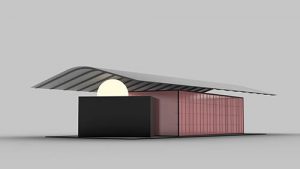New York-based industrial designer Todd Bracher is the creative brain behind the Das Haus installation at this month’s LivingKitchen exhibition in Cologne. He tells Rebecca Nottingham about his approach to the project and his views on the future of design in the KBB industry
You designed the Das Haus concept at this month’s LivingKitchen fair in Cologne. What does this kind of project mean to you as a designer?
It’s actually a lot more than just a house project or a concept. For me, it’s a way to explore my own design process and the possibilities of design without having to focus on solutions that will work commercially. And that freedom is a kind of challenge too. That’s one part of it. But obviously, the more interesting part is creating this pavilion and enabling visitors to experience our thinking, to understand the ideas behind this experiment. It’s about creating a memory, creating a moment that they can remember.
How did you approach the project?
I looked at how people live. The tradition of a classic sequence of rooms with a view from the kitchen to the living room and from there into another space – the outside space, maybe – is still very much alive. But now that we’ve moved away from the idea of segmented, independent rooms and towards a more open space, a more open way of living, where do we go from here? What comes next if we take this open approach further? The fact is we often live in old houses that were planned according to what people needed at the time they were built. But especially when it comes to the sizes of rooms and their functions, those needs are very different from our own.
With Das Haus, we asked ourselves what a home might look like if it were based on today’s cultural needs. Because, let’s be honest, what are we doing right now to adapt the way we live and the kinds of home we live in to today’s world? Nothing. Perhaps that’s why our cities are forever coming up with solutions to compensate for the things we’re missing – that’s why people go to the bar or the gym or the spa.
What makes your Das Haus so different from other versions of the installation?
I’d say it’s blurring the zones that makes it so unusual. Rather than interpreting the home as a physical space, I’ve tried to make the physical space something you can experience as a psychological space. Basically, the house only consists of three spaces: one for sustenance or nutrition, one for rest and one for hygiene.
You’ve turned the traditional layout of the home on its head. Do you think this concept will really encourage people to explore new ways to live and design their homes?

In some ways, it’s just a concept. It’s not a concrete suggestion of how you should live, just an invitation to think about it in a new way. And hopefully visitors will go home having experienced how they can live differently, and perhaps consider it and then make their own choice. Until these sorts of explorations are exposed en masse to mainstream media, it will always be a challenge. However organically we evolve, as we have for thousands of years, I feel designers can have an influence – that’s what is so wonderful about what we do.
In your interpretation of Das Haus, the bathroom is outside. Do you think that will ever catch on and become a reality again?
Das Haus is an experiment in meaningful living. I’m not interested in any particular ideas ‘catching on’. For me, it is more rethinking how we live and what is meaningful for our lives. We wanted to try out the idea of putting the room for hygiene and washing outside. There’s something very beautiful about the idea of showering outdoors.
Why go inside to do something with water when water is such an organic, natural element? Outdoors, the emotional experience seems so much more interesting than when it takes place inside an aesthetic, man-made structure.
What’s the feedback about the concept been like?
The feedback has been very welcome. My views that we are living in such an oversaturated world, surrounded by far too much, has resonated well and many of the comments have suggested this design is timely. One comment was that it was interesting that this way of thinking came from an American.
What is ‘good’ design?
Design means different things to different people, but ultimately I believe it should be about bridging business objectives with an actual market need. It should be used as a strategic tool to articulate and position a business to establish a competitive advantage. Done properly, design can tangibly and forcefully create a strong connection between a company and a market, and drive growth.
What do you think the KBB industry is missing in terms of design?
I feel that much of the kitchen and bathroom industry tends to focus on aspirations, but do not offer solutions for actual life. Almost like the fashion world, where they feature an amazing €10,000 dress that is not realistic for anyone to actually wear. What’s missing is an honest, genuine attempt at understanding true human needs. How does one work in a real-world-sized kitchen – with a baby in one arm, the phone on your shoulder, while you prepare breakfast for the family and have to leave for work in 30 minutes.
Do you think the KBB industry has reached its peak of creativity?
No, this will never happen in any industry. Ever.
Is smart-home technology really the future or is it just a gimmick?
This kind of technology is a logical development, but I feel that the smart home of the future will be more transparent. It will work for you without you actually knowing. It will be more about managing water, waste and interior climates in a more efficient, intelligent way.
You didn’t include any smart technology in your version of Das Haus. Why is that?
I did not. I didn’t feel that technology was an important part of my message. In fact, in some ways, I believe the opposite. I wanted to communicate, real and authentic, truth and tactile – not artificial, fake or digital.
